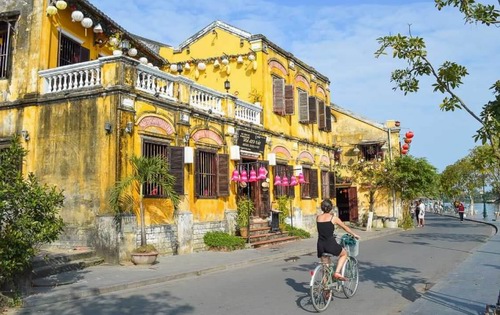|
Located 30 km south of
Danang, the
port town of Hoi An was called Faifo
at the time of the first Westerners arrived and
was one of the most important ports of Southeast
Asia from the seventeenth to the nineteenth
century. At its peak time, Hoi An was the
destination for merchant vessels from the
Netherlands, Spain, Portugal, China and
Japan...More than any other city in
Vietnam, Hoi
An retains the atmosphere of the old days when
it used to be one of the most prosperous port
towns in Asia
 Hoi An is an exceptionally well preserved
example of a city that was a trading port in
Southeast Asia.. Its buildings and narrow
streets reflect indigenous traditions as well as
the foreign influences that gave birth to this
unique heritage. Hoi An is an exceptionally well preserved
example of a city that was a trading port in
Southeast Asia.. Its buildings and narrow
streets reflect indigenous traditions as well as
the foreign influences that gave birth to this
unique heritage.
The city of Hoi An is one of the six World
Heritage of Unesco in Vietnam. Hoi An was known
to European navigators as Faifo, deformation of
Pho Hai which mean merchants seaside resorts
throughout Asia ships anchored in the harbor of
the city from the fifteenth century. Dealers and
foreign residents came and built beautiful
wooden houses. Unfortunately, during the
insurrection of Son Tay rebellion, the town was
almost completely razed, only the Chinese
rebuilt their neighborhood. The Japanese
preferred to leave the country. The gradual
silting up of the port of Hoi An favored the
rise of the new port of
Da Nang, so that trade
gradually ceased in Hoi An
Hoi An was miraculously spared by the recent
wars in Vietnam. The city boasts of its old
quarters typically Asian and well preserved,
unlike most Asian cities are racing to
modernity.
It identifies Hoi An more than 800 historic
buildings including bridges, pagodas, temples,
houses, communal house, graves, wells and so on.
In addition, when you go to Hoi An, you have a
good opportunity to
visit My Son, another World
Heritage Site just 50 km from Hoi An. This site
includes 70 architectural works of brick and
stone, built between the VII and XIII century.
Their architectural diversity demonstrates the
genius and skill of the artisan Cham people. The
ruins of My Son are referred to another great
civilizations of Southeast Asia, the temples of
Angkor Wat. Built by King Bhadresvaraman at the
end of the fourth century, My Son became a place
of worship of the Champa Kingdom. The Chams were
Hindus and it is for this reason that there are
many sculptures of gods Shiva, Ganesh, Vishnu in
My Son.
With the rise of Buddhism between 758 and 915,
the site of My Son continues for some time to be
the center of religion and the "genius master of
the Creator", but the beginning of the tenth
century, perhaps because recovery of Shaivism in
the administration of Chams, My Son again to be
a place of influence. Through worship,
restoration and construction as the Cham people
have made My Son more architectural and
sculptural remains than any other place in the
kingdom of Champa.
After the fifteenth century, the site fell into
oblivion and no archive of the old Vietnamese
dynasties mentioned it. Thus, when the French
discovered in the late nineteenth century, My
Son was fully engulfed in the jungle, in the
image of Angkor Wat.
Unfortunately, despite having survived the Khmer
invaders, Chinese or French, My Son has been
extensively damaged by American bombers during
the Vietnam War.
|
 Travel Blog
Travel Blog